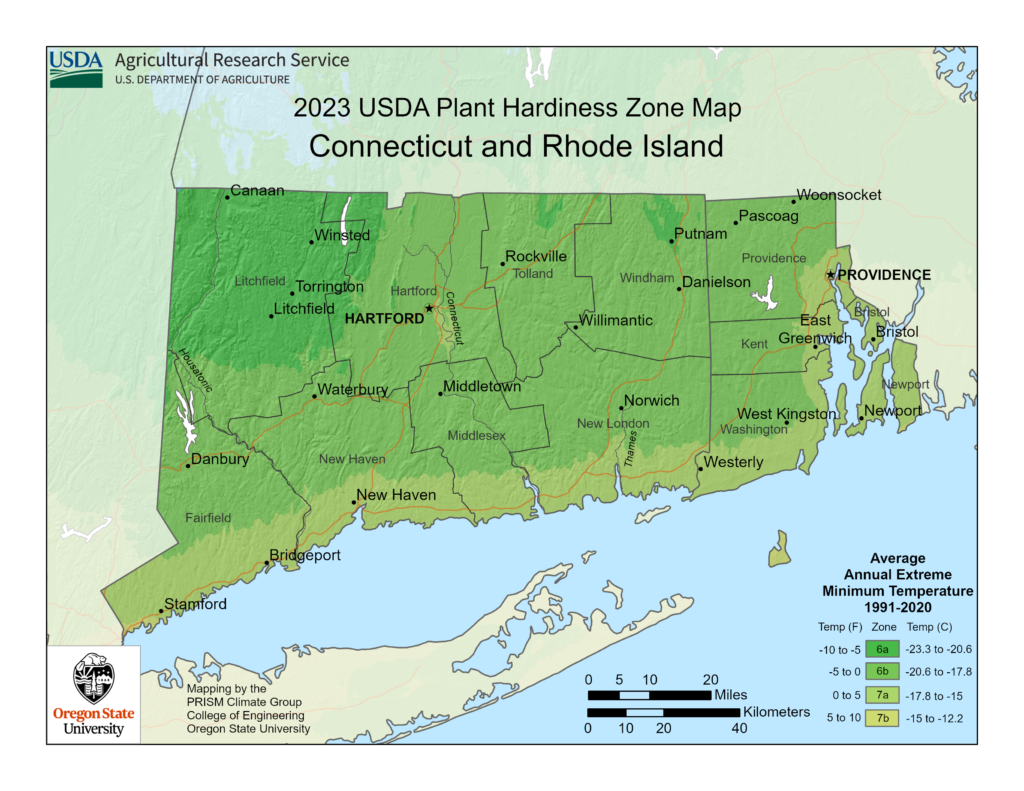
Are you dreaming of creating a tropical oasis in your Connecticut garden? Contrary to popular belief, palm trees can actually grow in the colder climate of New England. With the right care and selection of cold-hardy species, you can enjoy the beauty and elegance of palm trees right at home.
While the colder Connecticut climate does limit your inground options to just a few varieties of cold hardy palms, many choose to grow other varieties in pots to bring in during the winters.
However, particularly brutal winters and polar vortexes will likely kill even the hardiest of palms in Connecticut
Best Cold-Hardy Palm Tree Species for Connecticut
When it comes to selecting palm tree species for your Connecticut landscape, it’s crucial to choose varieties that can withstand the cold climate. Here, we will explore some of the best cold-hardy palm tree species that can thrive in Connecticut.
1. Windmill Palm (Trachycarpus fortunei)
The Windmill Palm, also known as Chusan palm, is one of the most popular palm trees for colder regions. It can tolerate temperatures as low as 0°F and even lower with proper care. This slow-growing palm features slender trunks covered in a dense layer of brown fibers and large fan-shaped leaves that give it a captivating aesthetic appeal.
2. Needle Palm (Rhapidophyllum hystrix)
The Needle Palm is a small to medium-sized palm that is native to the southeastern United States. It is one of the most cold-hardy palm trees, capable of withstanding temperatures as low as 0°F (-18°C). What sets this palm apart is its unique needle-like, sharp-edged leaves, which give it a distinct appearance.
3. Dwarf Palmetto (Sabal minor)
The Dwarf Palmetto is a compact palm tree that is well-suited for smaller gardens. It can tolerate temperatures down to 0°F (-18°C) and is native to the southeastern United States. With its attractive green leaves and compact size, the Dwarf Palmetto adds a touch of tropical elegance to any Connecticut landscape.
4. Saw Palmetto (Serenoa repens)
The Saw Palmetto, native to the southeastern United States, is a medium-sized palm with a high tolerance for cold weather. It can handle temperatures as low as 10°F (-12°C) and is known for its striking blue-green fan-shaped leaves. This palm tree is also prized for its medicinal properties and is commonly used in herbal remedies.
| Palm Tree Species | Cold Hardiness | Distinct Characteristics |
|---|---|---|
| Windmill Palm | -10°F (-23°C) and lower | Slender trunks, dense brown fibers, large fan-shaped leaves |
| Needle Palm | 0°F (-18°C) | Needle-like sharp-edged leaves |
| Dwarf Palmetto | 0°F (-18°C) | Compact size, attractive green leaves |
| Saw Palmetto | 10°F (-12°C) | Blue-green fan-shaped leaves, medicinal properties |
When planting your cold-hardy palm trees, it’s important to choose a location that provides adequate sunlight and well-drained soil. Proper planting techniques and regular maintenance will ensure the long-term health and beauty of your palm trees in Connecticut.
Palm Tree Care in Connecticut
Proper care is essential for palm tree survival in Connecticut. From planting techniques to winter protection strategies, there are several factors to consider in maintaining beautiful palm trees in your garden
Planting Techniques
Before planting your palm trees, it’s important to choose a suitable location that offers adequate sunlight and well-drained soil. Dig a hole that is twice the width of the root ball and slightly shallower than its depth. Gently place the palm tree into the hole and backfill with a mixture of soil and organic matter, ensuring the base of the trunk is level with or slightly above the surrounding soil.
Our soil recommendation for palms:
Watering Requirements
Palm trees require regular watering, especially during the hot summer months. Water deeply and infrequently to encourage deep root growth. Allow the top inch of soil to dry out between waterings to prevent waterlogged conditions. Consider installing a drip irrigation system to provide consistent moisture without overwatering.
Fertilization and Pruning
Regular fertilization is essential for palm tree health. Apply a slow-release palm tree fertilizer according to the manufacturer’s instructions during the growing season. Avoid over-fertilizing, as it can cause nutrient imbalances and burn the roots. Pruning should be limited to removing dead or damaged fronds to maintain the tree’s aesthetic appeal and prevent disease.
Our recommended palm fertilizer:
Winter Protection Strategies
Connecticut’s harsh winter conditions can pose a challenge for palm trees. To protect them during the colder months, consider wrapping the trunks with burlap or using a frost cloth to provide insulation. Apply a layer of mulch around the base to protect the roots from freezing temperatures. Be sure to remove the winter protection once the threat of frost has passed in the spring.
You can also consider planting your palms in a protected area close to a heat source. Locations closer to the house will act as an insulator and windbreak during the winter.
Protect your palms with hardy frost cloth:
FAQ
Can palm trees grow in Connecticut’s colder climate?
Yes, certain palm tree species can grow in Connecticut’s colder climate. However, it’s important to choose cold-hardy varieties and provide proper care and protection during winter months.
What are some essential care practices for palm trees in Connecticut?
Proper palm tree care in Connecticut includes planting in well-draining soil, providing adequate watering, regular fertilization, and pruning dead or damaged fronds. It’s also important to protect palm trees from cold temperatures and strong winds during winter.
Which palm tree species are best suited for Connecticut’s climate?
Some cold-hardy palm tree species that thrive in Connecticut include the Windmill Palm (Trachycarpus fortunei), Needle Palm (Rhapidophyllum hystrix), and Dwarf Palmetto (Sabal minor). These species can withstand the state’s cooler temperatures and are suitable for landscaping in the area.
Can I rent palm trees for my home or business in Connecticut?
Yes, www.ctpalmtrees.com is a business in Connecticut that rents out palms for the summer and stores them in a greenhouse for you during the winter.
